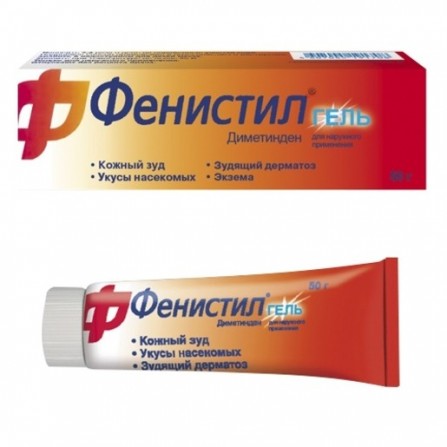Fenistil gel for external use 50 g
Condition: New product
1000 Items
Rating:
Be the first to write a review!

More info
Active ingredients
Dimetinden
Release form
Gel
Composition
100 g. Gel: dimetindena maleate 100 mg. Adjuvants: disodium edetate - 50 mg, carbomer - about 900 mg, sodium hydroxide (solution 30%) - about 1 g, benzalkonium chloride - 5 mg, propylene glycol - 15 g, water purified - about 82.9 g.
Pharmacological effect
Histamine H1 receptor blocker. It has anti-allergic and antipruritic effect. Reduces the increased capillary permeability associated with allergic reactions. When applied to the skin, it reduces itching and irritation caused by skin-allergic reactions. The drug also has a pronounced local anesthetic effect. It blocks the action of kinins, has a weak anticholinergic effect. When applied externally due to the gel basis, the action with a slight cooling effect begins after a few minutes and reaches its maximum after 1-4 hours
Pharmacokinetics
When applied topically, it penetrates the skin well. Systemic bioavailability of the active substance is 10%.
Indications
Pruritus of various origins (other than those associated with cholestasis) for: - pruritic dermatosis; - eczema; - urticaria; - insect bites. Solar burns, household and industrial burns (mild).
Contraindications
Angle-closure glaucoma; - hyperplasia of the prostate gland; - children up to 1 month (especially premature); - hypersensitivity to dimetinden and other components that make up the drug.
Precautionary measures
Precautions should be prescribed fenistil; in the first trimester of pregnancy and lactation (breastfeeding).
Use during pregnancy and lactation
Use of the drug Fenistil; in the first trimester of pregnancy, it is possible only after consulting a doctor. In the second and third trimesters of pregnancy and during lactation, the gel should not be used on large areas of the skin, especially in the presence of inflammation and bleeding. Nursing mothers should not apply the drug on the nipples of the mammary glands.
Dosage and administration
Apply externally. The drug should be applied to the affected skin 2-4 times / day. In cases of severe itching or common skin lesions, simultaneous oral administration is recommended.
Side effects
Determination of the frequency of side effects: very often (≥1 / 10), often (≥1 / 100 and <1/10), infrequently (≥1 / 1000 and <1/100), rarely (≥1 / 10 000 and <1 / 1000), very rarely (<1/10 000), including individual messages and reactions with unknown frequency (it is impossible to estimate based on the available data). On the side of the skin and subcutaneous tissues: rarely - dry skin, burning sensation of the skin. Allergic reactions: very rarely (post-registration data) - allergic dermatitis, including skin rash, itching. If any of the above side effects are aggravated, or any other side effects have appeared You, the patient should inform the doctor.
Overdose
Symptoms: if a large amount of the drug is accidentally swallowed, symptoms characteristic of histamine H1 receptor blockers may occur - CNS depression and drowsiness (mainly in adults), CNS stimulation and m-anticholinergic effects (especially in children), including excitement, ataxia, tachycardia, hallucinations, tonic or clonic convulsions, mydriasis, dry mouth, flushing to the face, urinary retention, fever. This may be followed by a decrease in AD. Treatment: the specific antidote is unknown. It should appoint an activated carbon, saline laxative; carry out activities to maintain the function of the cardiovascular and respiratory systems. For the treatment of arterial hypotension, vasoconstrictor agents can be used. In case of accidental overdose, the patient should consult a doctor.
special instructions
In cases of severe itching or damage to large areas of skin, the drug can be used only after consulting a doctor. When using the drug Fenistil; Exposure to sunlight should be avoided over large areas of the skin. If during the period of use of the drug Fenistil; the severity of symptoms of the disease does not diminish or increases, it is necessary to consult a doctor. The drug is ineffective with itching associated with cholestasis. The drug contains propylene glycol and benzalkonium chloride. The emulsion also contains butylhydroxytoluene. These excipients can cause local allergic reactions (contact dermatitis). Butylhydroxytoluene can also cause irritation of the eyes and mucous membranes. Use in pediatrics In children aged 1 month to 2 years, the drug should be used only after consulting a doctor. In infants and young children, it should not be used on large areas of the skin, especially if there is inflammation or bleeding. Influence on ability to drive motor transport and control mechanismsNot affected.





